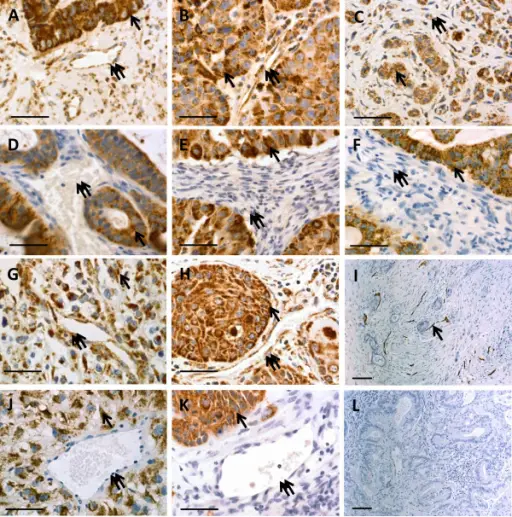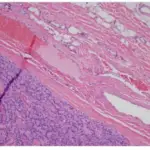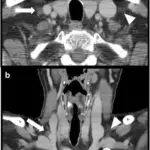Neoplasia is the uncontrolled, abnormal growth of cells or tissues in the body.
What is the Nomenclature for Neoplasia?
Neoplasia means new growth.
Key terms to describe neoplasia include Differentiation. Anaplasia. Pleomorphism. Nuclear Morphology. Mitosis. Polarity. Necrosis. Angiogenesis. Local invasion. Sentinel lymph nodes.
What is Differentiation?
Differentiation is how much or how little tumor tissue looks like the normal tissue it came from.
What is Anaplasia?
Anaplasia is a term used to describe cells that have lost the unique characteristics that define them as a certain tissue type.
What is Pleomorphism?
Pleomorphism is the existence of irregular and variant forms in the same species or strain of microorganisms.
What is Nuclear Morphology?
Nuclear morphology refers to the the size, shape, and position of the nucleus.
What is Mitosis?
Mitosis is a cellular process that replicates chromosomes and produces two identical nuclei in preparation for cell division.
What is Loss of Polarity?
Loss of polarity refers to abnormal positioning of cellular elements.
What is Necrosis?
Necrosis is the death of most or all of the cells in an organ or tissue due to disease, injury, or failure of the blood supply.
What is Angiogenesis?
Angiogenesis is the formation of new blood vessels. This process involves the migration, growth, and differentiation of endothelial cells, which line the inside wall of blood vessels.
What is Local Invasion?
Local invasion refers to the direct extension and penetration by cancer cells into neighboring tissues.
What are Sentinel Lymph Nodes?
Sentinel lymph nodes are the first lymph node to which cancer cells are most likely to spread from a primary tumor.
What is a Tumor?
A tumor is an abnormal mass of tissue that forms when cells grow and divide more than they should or do not die when they should. Tumors can be benign or malignant.
What is a Benign Tumor?
A benign tumor stays in its primary location without invading other sites of the body.
The characteristics of benign tumors include:
- Well-differentiated appearance
- Structure similar to tissue of origin
- Little or no anaplasia
- Slow expansion
- Rare mitotic figures
- No metastasis
What is a Malignant Tumor?
A malignant tumor is an abnormal growth that can grow uncontrolled and spread to other parts of the body.
The characteristics of malignant tumors include:
- Lack of differentiation
- Structure often atypical
- Variable degrees of anaplasia
- Slow to rapid growth
- Mitotic figures that are often numerous
- Frequent metastasis
What are Mixed Tumors?
Mixed tumors are neoplasms with more than one cell type but arising from only one germ layer.
What is a Preinvasive Neoplasm?
A preinvasive neoplasm is a cluster of malignant cells that have not yet invaded the deeper epithelial tissue or spread to other parts of the body.
What is Local Invasion?
Local invasion refers to the direct extension and penetration by cancer cells into neighboring tissues.
What is Metastasis?
Metastasis is the development of secondary malignant growths at a distance from a primary site of cancer.
Cancers are thought to be spread in three ways:
- Direct seeding
- Hematogenous spread
- Lymphatic spread
What is Direct Seeding?
Direct seeding is when cancer cells that break away from a primary tumor disseminate to other areas of the body and form more cancerous growth.
What is Hematogenous spread?
Hematogenous spread refers to the spread of tumor cells by the blood.
What is Lymphatic Spread?
The lymphatic spread refers to the spread of tumor cells through the lymph system.
What are the Most Common Cancers in Men?
The most common cancers in men are as follows:
- Prostate cancer
- Colorectal cancer
- Lung cancer
- Melanoma
What are the Most Common Cancers that Cause Death in Men?
The most common cancers that cause death in men are as follows:
- Lung cancer
- Prostate cancer
- Colorectal cancer
- Pancreatic cancer
- Liver and bile duct cancer
- Leukemia
- Esophageal cancer
- Bladder cancer
What are the Most Common Cancers in Women?
The most common cancers in women are as follows:
- Breast cancer
- Colorectal cancer
- Lung cancer
What are the Most Common Cancers that Cause Death in Women?
- Breast cancer
- Colorectal cancer
- Lung cancer
What Environmental Factors May Promote Cancer Development?
Environmental factors that may promote cancer development are:
- HPV: HPV lingers and infects the cells of the vulva, vagina, penis, or anus, it can cause cell changes called precancerous lesions which may eventually develop into cancer.
- Nitrosamines: Nitrosamines form a large group of genotoxic chemical carcinogens that occur in the human diet and other environmental media and can be formed endogenously in the human body.
- PVC: PVC associated with manufacturing and processing plants is a toxic chemical that is a well known human carcinogen.
- Cigarettes: Smoking cigarettes is well known to cause cancer, particularly of the lungs.
- Obesity: Obesity can cause long-lasting inflammation and higher than normal levels of insulin, insulin-like growth factor, and sex hormones which may promote tumor development.
- Poor diet: High consumption of foods rich in sugar, refined carbs, and processed meats, may increase the risk of cancer.
- Alcohol consumption can increase the levels of some hormones such as estrogen and insulin. Hormones are chemical messengers and higher levels can make cells divide more often, which raises the chance that cancer cells will develop.
- Hormonal exposure: Reproductive history that increases the duration and/or levels of exposure to ovarian hormones, which stimulate cell growth, have been associated with an increase in breast cancer risk.
- Carcinogens: Environmental carcinogens cause DNA mutations and they are known to cause cancer in the body by making changes in gene level.
Certain agents have known associations with cancers such as:
| AGENTS | RELATED CANCERS |
| Arsenic | Lung carcinoma, skin carcinoma |
| Asbestos | Mesothelioma, lung carcinoma |
| Benzene | Acute myeloid leukemia |
| Beryllium | Lung carcinoma |
| Cadmium | Prostate carcinoma |
| Chromium | Lung carcinoma |
| Nickel | Lung carcinoma |
| Radon | Lung carcinoma |
| Vinyl chloride | Hepatic angiosarcoma |
How does Age Relate to Cancer?
Age relates to cancer because our cells can get damaged over time.
How may Chronic Inflammation Lead to Cancer?
Chronic inflammation may lead to cancer by cell mutation and proliferation.
What are Precursor Lesions that May Lead to Cancer?
Precursor lesions that may lead to cancer are leukoplakia and erythroplakia.
What is the Molecular Basis of Cancer?
The molecular basis of cancer is the p53 gene. This tumor suppressor gene is mutated in about half of all human cancers. Nonlethal genetic damage in carcinogenesis lies at the heart of carcinogenesis. This genetic damage can be acquired or be inherited through the germline. Tumors may be formed by clonal expansion from a single precursor abnormal cell.
Four classes of normal regulatory genes include:
- Proto-oncogenes
- Growth-inhibiting tumor suppressor genes
- Genes involved in apoptosis
- Genes involved in DNA repair
| GENES | DEFINATION | EXAMPLE | FUNCTION |
| Proto-oncogenes | Proto-oncogenes are genes that normally help cells grow | Ras, HER2, Myc, Cyclin D | proto-oncogenes encode proteins that function to stimulate cell division, inhibit cell differentiation, and halt cell death. |
| growth-inhibiting tumor suppressor genes | Tumor suppressor genes keep the processes of cell growth and cell death (apoptosis) in check | BRCA1/BRCA2 genes | It makes a protein called a tumor suppressor protein that helps control cell growth |
| Genes involved in apoptosis | Deregulation of apoptosis results from translocations involving genes that encode cell death–regulating proteins. | p53 gene | The protein it codes for belongs to a family of proteins that has three members: P53, P63, and P73. |
| Genes involved in DNA repair | These genes are specifically designed for DNA repair | DMC1, XRCC2, XRCC3, RAD52 | It participates in the DNA damage response |
What is Clonality?
Clonality is visualized as the over-representation of a single gene product present in a polyclonal background. Clonality relates to cancer because cancer stem cell arises by clonal evolution as a result of selection for the cell with the highest fitness in the neoplasm.
What does the Development of Cancer Involve?
The development of cancer involves:
- Initiating mutation
- Acquisition of genomic instability
- Acquisition of cancer hallmarks
- Further genetic alterations
| Genes | Cancers Associated With Genes |
| Protooncogenes | Burkitt’s lymphoma |
| Growth factor receptors | Lung cancer |
| ERBB1 | Lung cancer, breast cancer, ovarian cancer |
| ERBB2 | Breast cancer, ovarian cancer, stomach cancer, bladder cancer, salivary cancer, and lung cancer |
| Gene rearrangements | Colorectal cancers |
| RAS mutations | Pancreatic cancer, lung cancer, colorectal cancer |
| BRAF mutations | Thyroid cancers |
| P13K mutations | Bladder cancer, colon cancer, ovary cancer |
| Tyrosine Kinases | Breast cancer |
| Transcription factors | Leukemia, colorectal cancer, lung cancer, breast cancer. |
| JAK/STAT | Lung cancer, leukemia, lymphoma |
| MYC Oncogene | Multiple myeloma |
| Tumor suppressor genes | Lung cancer, prostate cancer, melanoma. |
| p53 | Breast cancer, colorectal cancer, liver cancer, lung cancer, ovarian cancer. |
| APC | Gastric cancers, colorectal cancer |
| E-Cadherin | Gastric cancer |
| CDKN2A | Melanoma |
| TGF-B pathway | Non-epithelial cancers |
| PTEN | Breast cancer |
| NF1 | Sarcoma, peripheral nerve sheath tumor, brain cancer, breast cancer |
| WT1 | Kidney cancer |
| PATCHED (PTCH) | Basal cell carcinoma |
| VHL | Kidney cancer, pancreatic cancer |
| STK11 | Breast cancer |
| BCL2 | B-cell leukemias and lymphomas |
What is The Warburg Effect?
The Warburg effect is a form of modified cellular metabolism found in cancer cells, which tend to favor a specialized fermentation over the aerobic respiration pathway that most other cells of the body prefer.
| Ways cancer avoids dying | Brief Description |
| Evasion of Apoptosis | The evasion of apoptosis is one of the hallmarks of human cancers that promote tumor formation and progression as well as treatment resistance. It results from a cellular stress response. |
| Angiogenesis | Angiogenesis plays a critical role in the growth of cancer because solid tumors need a blood supply if they are to grow beyond a few millimeters in size. |
| Invasion | Invasion is the direct extension and penetration by cancer cells into neighboring tissues. |
| Metastasis | Metastasis is the development of secondary malignant growths at a distance from a primary site of cancer. |
| Genomic Instability | High frequency of mutations within the genome of a cellular lineage. |
| Cancer-Enabling Inflammation | Cancer cells hijack inflammatory mechanisms to promote their growth and survival. |
| Dysregulation of Cancer-Associated Genes | Cancer initiates from genetic alterations, including mutations, deletions, and copy number gains, that function to activate cancer-promoting pathways or to block processes that normally inhibit cancer development. |
| Invasion of Extracellular Matrix | The process of invasion involves adherence of the tumor cells to the extracellular matrix (ECM), degradation of matrix components, and movement of the cell body. |
| Evasion of Host Defense | Method to avoid or inactivate host defenses and ensure their survival within a host. |
What is Cachexia?
Cachexia is a wasting disorder that causes extreme weight loss and muscle wasting and can include loss of body fat.
What are Paraneoplastic Syndromes?
Paraneoplastic syndromes are conditions that are due to malignancies producing hormones or hormone like products.
Paraneoplastic syndromes include:
| Syndrome and (Cause) | Cancer |
| Dermatologic Disorders | |
| Acanthosis Nigracans(Immunologic; secretion of epidermal growth factor) | Gastric CarcinomaLung CarcinomaUterine Carcinoma |
| Dermatomyositis(Immunologic) | Breast CarcinomaBronchogenic Carcinoma |
| Endocrine Disorders | |
| Cushing Syndrome(ACTH or ACTH-like Substance) | Neural TumorsPancreatic CarcinomaSmall-Cell Carcinoma of Lung |
| Hypercalcemia(Parathyroid Hormone-Related Protein, TGF-a, TNF, IL-1) | Adult T-cell Leukemia/LymphomaBreast CarcinomaRenal CarcinomaSquamous Cell Carcinoma of Lung |
| Hypoglycemia(Insulin or Insulin-like substance) | FibrosarcomaOvarian CarcinomaOther Mesenchymal Sarcomas |
| Polycythemia(Erythropoietin) | Cerebellar HemangiomaHepatocellular CarcinomaRenal Carcinoma |
| SIADH(ADH, Atrial Natriuretic Hormones) | Intracranial NeoplasmsSmall Cell Carcinoma of the Lung |
| Muscle & Nerve Syndromes | |
| Disorders of CNS and/or PNS | Breast Carcinoma |
| Myasthenia(Immunologic) | Bronchogenic CarcinomaThymic Neoplasms |
| Soft Tissue & Bone Changes | |
| Clubbing of fingers and hypertrophic osteoarthropathy(Unknown) | Bronchogenic CarcinomaThymic Neoplasms |
| Nephrotic Disorders | |
| Nephrotic Syndrome(Immune complexes, Tumor Antigens) | Cancers |
| Vascular & Hematologic Changes | |
| Disseminated Intravascular Coagulation(Clotting pathway activated by tumor products) | Acute Promyelocytic LeukemiaProstatic Carcinoma |
| Nonbacterial Thrombotic Endocarditis(Hypercoagulability) | Cancers that have advanced |
| Red Cell Aplasia(Unknown) | Thymic Neoplasms |
| Venous Thrombosis(Clotting pathway activated by tumor products, mucins) | Bronchogenic CarcinomaPancreatic CarcinomaOther Cancers |
What is the Grade of Cancer?
Grade of cancer describes how abnormal the cancer cells and tissue look under a microscope when compared to healthy cells.
What is the Stage of Cancer?
Stage of cancer is the process of finding out how much cancer is in a person’s body and where it is located. Stage is more important than grade 99.8% of the time.
What is Immunohistochemistry?
Immunohistochemistry is the most common application of immunostaining. It involves the process of selectively identifying antigens (proteins) in cells of a tissue section by exploiting the principle of antibodies binding specifically to antigens in biological tissues.
What are Molecular Profiles?
Molecular profile is a form of testing that classifies tumors based on this genetic make-up to help diagnose and formulate targeted therapy to treat the malignancy.
What are Tumor Markers?
Tumor markers are anything present in or produced by cancer cells or other cells of the body in response to cancer or certain benign (noncancerous) conditions that provides information about cancer, such as how aggressive it is, what kind of treatment it may respond to, or whether it is responding to treatment.
Examples of tumor markers include:
- HCG
- Calcitonin
- a-Fetoprotein
- CAE
- PAP
- NSE
- IgGs
- PSA
- CA-125
- Cell-Free DNA Markers
| Tumor Markers | Cancer Types | What is Analyzed | How the Results are Used |
| HCG | Choriocarcinoma and germ cell tumors | Urine or blood | To assess stage, prognosis, and response to treatment |
| Calcitonin | Medullary thyroid cancer | Blood | To aid in the diagnosis, check whether treatment is working, and assess recurrence |
| a-Fetoprotein | Liver cancer and germ cell tumors | Blood | To help diagnose liver cancer and follow response to treatment; to assess stage, prognosis, and response to treatment of germ cell tumors |
| CAE | Colorectal cancer and some other cancers | Blood | To keep track of how well cancer treatments are working and check if cancer has come back or spread |
| PAP | Metastatic prostate cancer | Blood | To help in diagnosing poorly differentiated carcinomas |
| NSE | Small cell lung cancer and neuroblastoma | Blood | To help in diagnosis and to assess response to treatment |
| IgGs | Multiple myeloma and Waldenström macroglobulinemia | Blood and urine | To help diagnose disease, assess response to treatment, and look for recurrence |
| PSA | Prostate cancer | Blood | To help in diagnosis, to assess response to treatment, and to look for recurrence |
| CA-125 | Ovarian cancer | Blood | To help in diagnosis, assessment of response to treatment, and evaluation of recurrence |



